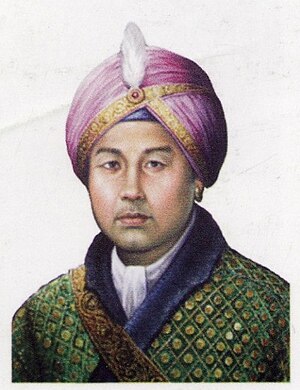Chinglen Nongdrenkhomba
| Chinglen Nongdrenkhomaba Gambhir Singh | |
|---|---|
| King of Manipur | |

Portrait by RKCS
|
|
| King of Manipur (more...) | |
| Reign | April 1821 to October 1821 and 12 June 1825 to 9 January 1834 |
| Coronation | 6 June 1831 |
| Predecessor | Badra Singh, father of Maharaja Nara Singh |
| Successor | Chandra kriti |
| Born | 5 March 1788 Langthabal Palace, Canchipur |
| Died | 9 January 1834 (aged 47) Langthabal Palace, Canchipur |
| Consort | Meetei Leima Maipung Lanthabi, Meetei Leima Maisnam Kumudini |
| Issue | Chandra Kirti ( also known as Ningthem Pisak), Princess Shija Tamphasana, Prince Ibungshija Raj Singh |
| House | Ningthouja Dynasty Royal family of Manipur |
| Father | Chingthang Khomba |
| Mother | Queen Khumong Mayum Chanu |
| Religion | Hindu |
| Kingdom of Manipur | |
|---|---|
| Part of History of Manipur | |
| Kings of Manipur | |
| Pamheiba | 1720-1751 |
| Gaurisiam | 1752-1754 |
| Chitsai | 1754-1756 |
| Ching-Thang Khomba | 1769-1798 |
| Rohinchandra | 1798-1801 |
| Maduchandra Singh | 1801-1806 |
| Chourjit Singh | 1806-1812 |
| Marjit Singh | 1812-1819 |
| Gambhir Singh | 1825-1834 |
| Raja Nara Singh | 1844-1850 |
| Debindro Singh | 1850 |
| Chandrakirti Singh | 1850-1886 |
| Raja Surchandra | 1886-1890 |
| Kulachandra Singh | 1890-1891 |
| Churachandra Singh | 1891-1941 |
| Bodhchandra Singh | 1941-1949 |
| Manipur monarchy data | |
| Ningthouja dynasty (Royal family) | |
| Pakhangba (Symbol of the kingdom) | |
| Cheitharol Kumbaba (Royal chronicle) | |
| Imphal (Capital of the kingdom) | |
| Kangla Palace (Royal residence) | |
Chinglen Nongdrenkhomba (1788–1834), also known as Raja Gambhir Singh, was a ruler of the Manipur Kingdom.
He was a son of Chingthang Khomba. He succeeded his nephew Yumjaotaba in April 1821 during the seven years devastation. He abdicated the throne with the arrival of a Burmese force under his cousin Prince Jai Singh, the first puppet king of Manipur under Burmese suzerainty, in October 1821. Gambhir Singh fled to Cachar.
In Cachar, Gambhir Singh with the help of his elder brothers Chourjit and Marjit dethroned Govinda Chandra, the king of Cachar. Govinda Chandra applied for the protection of the British East India Company. His request was refused. In consequence of which he applied to the King of Burma to reinstate him. Accordingly, in 1823 the king of Burma send a large army into Cachar from to arrest Chourjit, Marjit and Gambhir Singh. The Burmese forces proceeded up to the territory of British East India Company. In March 1824, Lord Amherst, the then Governor General of British India declared war against Burma. In 1823, the British Government opened communications with Gambhir Singh; upon which 500 Meiteis under his command were taken into pay of the British Government, and co-operated with the British troops in driving out the Burmese out of Cachar. This force of 500 men was known as Gambhir Singh Levy (later Manipur Levy). The Manipur Levy under Gambhir Singh and his second cousin Nara Singh, later Maharaja Nara Singh, played a key role in driving out the Burmese from cachar and Manipur. The First Anglo-Burmese War was ended with the defeat of the Burmese. A peace treaty was signed between the Burmese and the British on 24 February 1826 known as the Treaty of Yandaboo. According to the article no.2 of the Treaty Gambhir Singh was declared the independent ruler of Manipur. Gambhir Singh reigned until his death on 9 January 1834. He was succeeded by his infant son Chandra Kriti with Maharaja Nara Singh as regent.
...
Wikipedia
